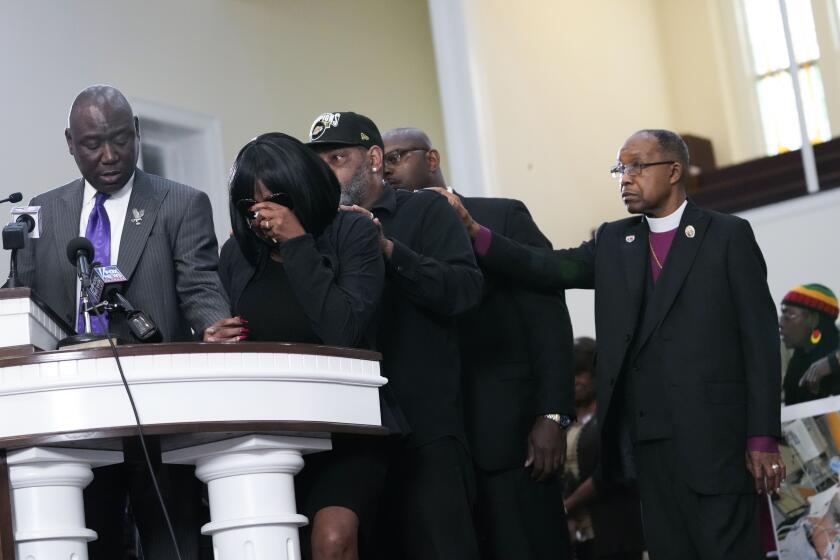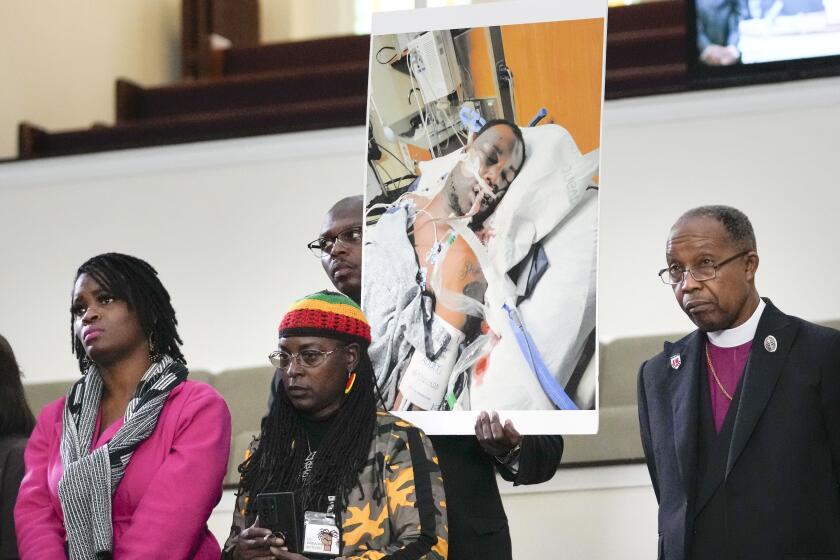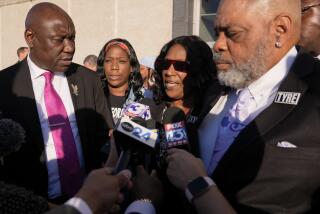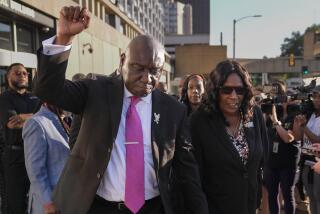Video shows Memphis officers kicking, punching Tyre Nichols as he calls for his mother
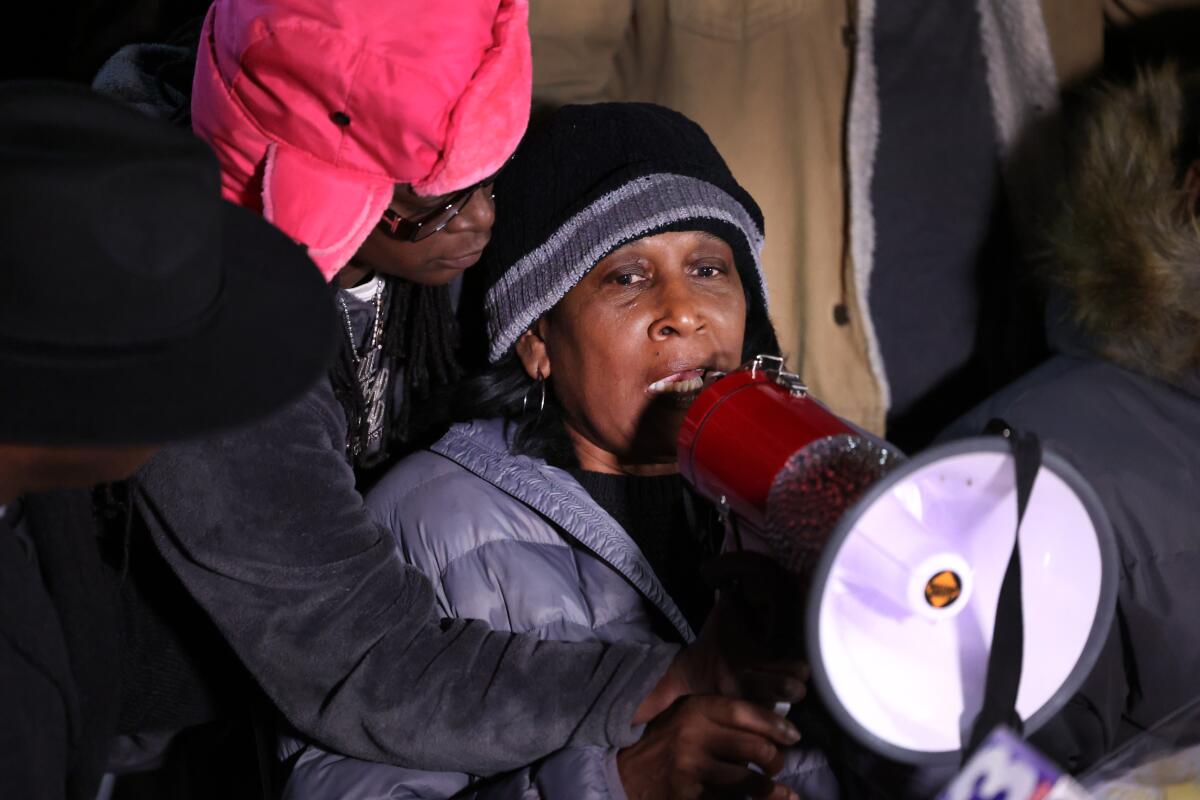
- Share via
MEMPHIS, Tenn. — The city of Memphis released nearly an hour of graphic video Friday evening showing the beating of Tyre Nichols, footage capturing a traffic stop that spiraled into a savage display of force, once again leaving an American city reeling from police violence.
The video — which includes numerous angles from police body-camera footage — shows the violent encounter between Nichols, a 29-year-old Black man, and police during his Jan. 7 arrest, which stemmed from a traffic stop. Nichols died three days later from his injuries.
- Share via
The city of Memphis has released video footage showing officers attacking Tyre Nichols after a traffic stop.
The highly anticipated footage formed the basis of murder charges that were filed Thursday against five Black former Memphis police officers from the department’s controversial “SCORPION” unit and set off protests across the country. The five fired officers — Tadarrius Bean, Demetrius Haley, Emmitt Martin III, Desmond Mills Jr. and Justin Smith — were released from the Shelby County Jail early Friday morning, according to jail records. The officers were released on bail ranging from $250,000 to $350,000, according to the Shelby County district attorney.
Four videos of the incident were released — three of which were recorded by cameras worn by officers and a fourth from a pole-mounted police camera in the neighborhood where the beating occurred. The video starts when officers stop Nichols.
Police are seen with their guns drawn the moment they step out of their cars and approach Nichols, who is still in the driver’s seat of his car in the middle of a lane.
“You gonna get your ass blown the f— out,” one officer yells while Nichols is still in the car. Numerous officers have their guns drawn.
An officer tells Nichols to get out of the car, then drags him from the driver’s seat.
“I didn’t do anything,” Nichols says as he is hauled from the car. “All right, I’m on the ground.”
“OK. Stop,” Nichols says as officers scream at him to get on the ground. “OK, dude, dang. … You guys are really doing a lot right now. … I can’t breathe.”
Nichols gets up after about 30 seconds on the ground by his car and begins to run away. An officer tries to shoot him with a Taser, though it’s not clear if it hits Nichols.
Another video shows police chasing Nichols after he gets up and runs and tackling him near a curb.
Footage from the pole camera shows a subsequent interaction, after police tackle Nichols to the ground following a chase.
“Shut the f— up,” one officer yells as Nichols screams from the ground.
“You want to get sprayed again?”
Nichols can be seen wiping his face after getting pepper-sprayed.
When Nichols is already on the ground, one officer makes the others move.
“Watch out, I’m gonna baton the f— out of you,” he yells at Nichols.
Nichols gets back to his feet and is moaning as another officer punches him in the face with his left hand.
“All right, all right,” Nichols says.
Nichols calls and screams for his mother numerous times throughout the encounter.
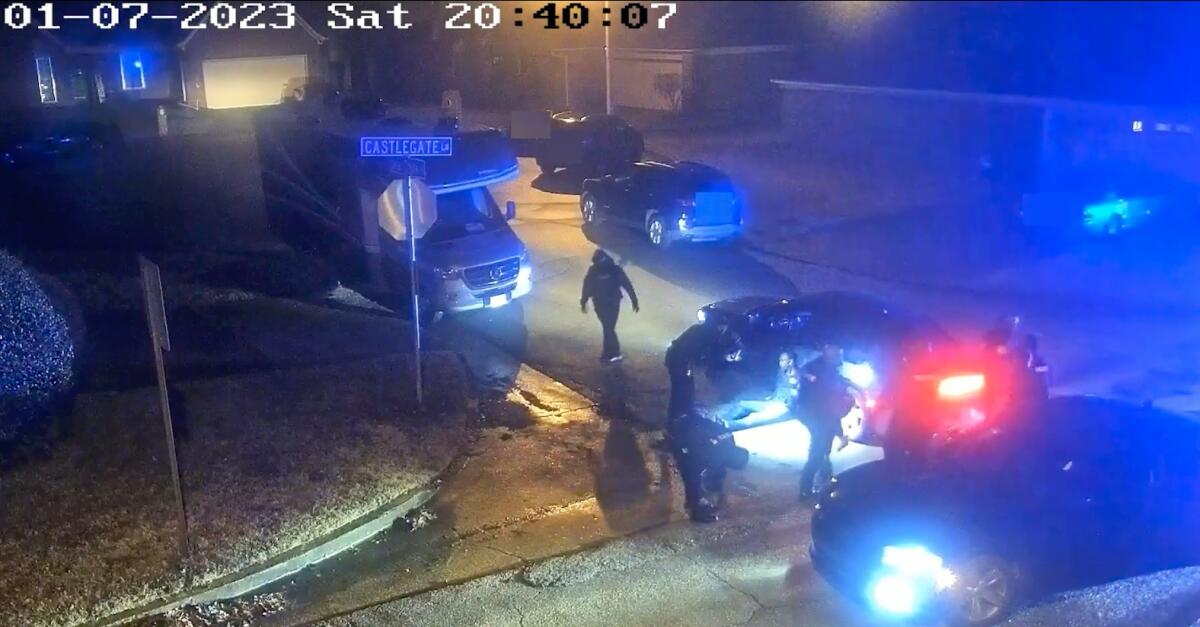
Three officers kick him and attempt to restrain him as Nichols lies on the ground by a curb. After a few minutes of police hitting and attempting to restrain Nichols, they sit him up against a police vehicle. From there, Nichols slumps to the ground, without officers noticing for nearly a minute.
The video does not show any officer attempt to de-escalate the situation, nor does it show any officer tell another to stop attacking or restraining Nichols. It is not clear in the footage if Nichols refuses to give police his hands.
In no part of the video viewed by The Times does Nichols appear to fight back against police.
After the confrontation ends, the police officers involved in the chase and beating discuss what has just happened as they catch their breath and wipe pepper spray from their eyes. Some agree that Nichols must have been high on something. Others say he was driving into oncoming traffic when they pulled him over. They talk about their roles in the incident.
“Man, I was hitting him with straight haymakers, dog,” one officer says.
Other officers say they were “rocking” Nichols but also say to one another that he was grabbing for their guns.
“He literally had his hand on my gun,” one officer says.
Officers can be heard laughing as Nichols slumps to the ground from an upright position propped against the car.
“He high as a motherf—,” one officer says.
“Hey sit up, bro,” an officer yells at Nichols when he realizes that the man has collapsed. “Sit up, man.”
The officer then lifts a limp and bloodied Nichols back into an upright position.
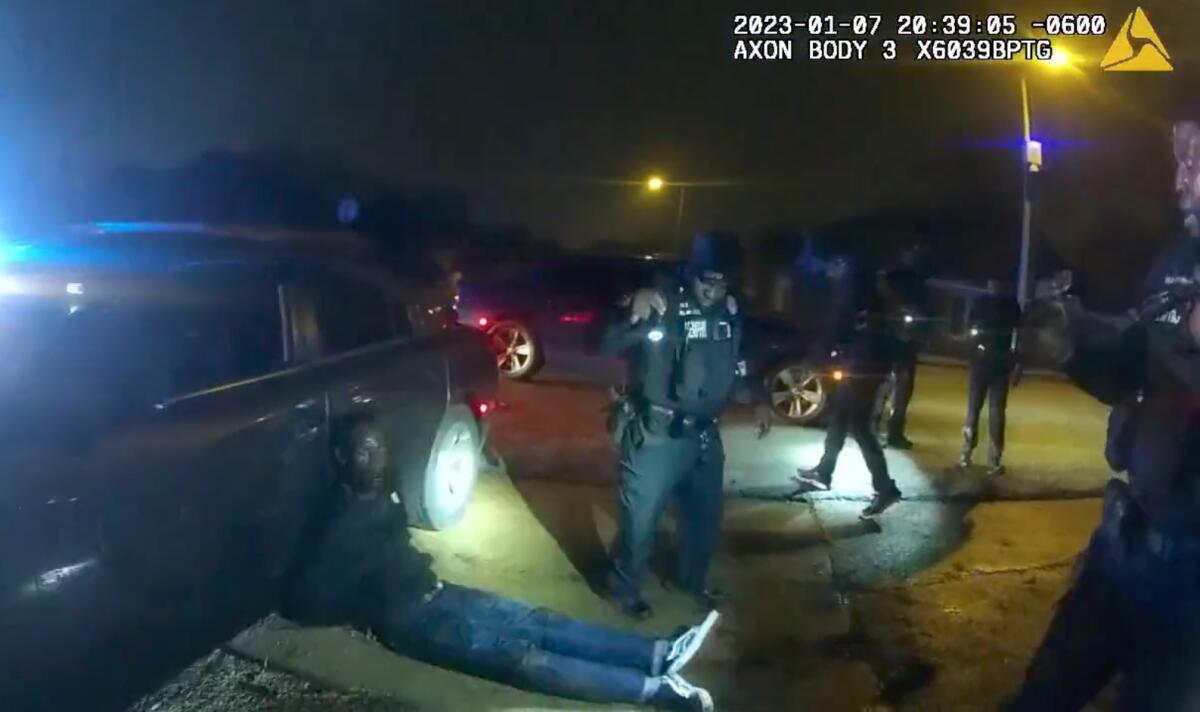
Before the video was released Friday, Nichols’ family called for peaceful protests.
RowVaughn Wells — Nichols’ mother — made the plea at a candlelight vigil Thursday in honor of her son and at a Friday news conference. Wells, who said her son’s encounter with police occurred as he was returning from a public park where he enjoyed taking photos, told those at the vigil: “We want peace.
“I want each and every one of you to protest in peace. If you guys are here for me and Tyre, then you will protest peacefully,” she said. Wells noted that she chose not to watch the video.
“We do not want any type of uproar, any type of disturbance. That’s what [the] family wants. That’s what [the] community wants. Please, please protest, but protest safely,” Rodney Wells, Nichols’ stepfather, said at Friday’s news conference.
The couple spoke at the morning event in the airy Mt. Olive Cathedral Christian Methodist Episcopal Church on Dr. Martin Luther King Jr. Boulevard, a prominent street in downtown Memphis on which King marched with striking sanitation workers days before his assassination in 1968.
“I want to say to the five police officers that murdered my son,” RowVaughn Wells said, tearing up on the stage of the church, “you also disgraced your own families when you did this. I’m going to pray for you and your families.”
Lawyers for the Nichols family have compared the video to footage of the 1991 Rodney King beating, but in higher definition.
“This is far worse than Rodney King,” said Ed Obayashi, a Northern California sheriff’s deputy and use-of-force expert. “In all my years of use-of-force cases, I have never [seen] one where they are holding him up to beat him.”
Responses by politicians began pouring in Friday evening, with President Biden saying he was “outraged and deeply pained to see the horrific video of the beating that resulted in Tyre Nichols’ death.”
Los Angeles Mayor Karen Bass criticized the officers seen in the footage.
“Tonight, we saw ferocious violence from an out of control herd,” Bass said in a statement. “No words can express the chilling familiarity of a Black man crying out for his mother as he is beaten to death by officers.”
Tyre Nichols died days after a “savage” attack by Memphis police that attorneys for the family say was reminiscent of the Rodney King beating.
The death of Nichols comes after the Memphis Police Department, like many nationwide, enacted reforms after the murder of George Floyd in Minneapolis in May 2020.
Memphis police adopted reforms such as requiring its officers to intervene if they witnessed misconduct or excessive force by their colleagues — following a model set by a nationwide police reform initiative called 8 Can’t Wait, according to UCLA law professor Joanna Schwartz, who studies police accountability.
With the Nichols beating, the country could be “headed into another moment of reckoning just a few years after George Floyd’s murder,” Schwartz said.
She said she was surprised by the speed with which the officers involved were fired and charged, calling it “very unusual for these kind of cases. Officers are really rarely disciplined or, even more rarely, criminally prosecuted.”
“The Police Department is acting uncharacteristically for any law enforcement agency, uncharacteristically quickly, to have fired the officers,” Schwartz said.
The release of the video put police in Memphis and across the country on notice for protests.
In New York City, hundreds of protesters gathered in Times Square. Three people were arrested around 9 p.m. in Midtown Manhattan on suspicion of causing damage to a police vehicle, said a New York Police Department spokesman.
In downtown Los Angeles, about 100 people gathered outside LAPD headquarters to hold a candlelight vigil for Nichols and Keenan Anderson, who died this month after L.A. police pinned him to the ground and discharged a Taser on him at least six times in 42 seconds.
The group burned sage and hung signs calling for abolishing police over barricades the LAPD had set up.
After the vigil, officers in riot gear assembled as a small group knocked over the metal barricades and marched into a plaza outside the police headquarters lobby. Under “Los Angeles Police Department” on the side of the building, someone spray-painted in red the word “kills.”
By 10:15 p.m., the crowd had shrunk to about 30 people as insults and smoke of indeterminate provenance filled the air. Some demonstrators shook and banged on a police car with an officer sitting inside.
Activists on the ground in Memphis expressed frustration with speculation that the city would erupt in chaos after the release of the video, saying the brutal imagery should instead spark questions about the policing culture fostered by Memphis Mayor Jim Strickland and Police Chief Cerelyn Davis.
“I think my biggest quarrel with messaging is this anticipation for a riot versus the hard questions that should be asked to the mayor and the police chief,” said Keedran Franklin, the co-founder of the Memphis Coalition of Concerned Citizens, who also organizes with the national group Black Men Build.
“No one has ever seen Memphis go up in flames. We’ve had major protests here,” Franklin said. “We don’t get violent.”
Five fired officers have been charged with second-degree murder, official misconduct, official oppression, aggravated assault while acting in concert, and aggravated kidnapping.
Large-scale protests that some feared could spring up never materialized in Memphis. Downtown businesses mostly remained open Friday, though a few stores closed early in light of the video’s release. People were eating at restaurants, and a few shops were boarded up.
When the video was released, a group of more than 100 protesters began marching from Martyrs Park, just south of downtown Memphis. Some clutched homemade signs demanding justice. Familiar chants of “No justice, no peace” roared from the crowd as they marched onto Riverside Drive.
Protesters held court on a section of Highway 55. The demonstrations were peaceful, even as several speakers signaled their intent to defy any law enforcement efforts to clear the highway until their demands were met. Police mostly kept their distance.
The blues clubs that line popular Beale Street were packed with patrons.
Protesters reached the bridge that spans the Mississippi River between Tennessee and Arkansas, then turned back and began heading toward Martyrs Park.
Standing off to the side was a man with his family, including three young children.
The man, who declined to give his name, said he felt compelled to attend the rally because he lived in the area and felt solidarity with those calling for change.
“Sometimes it takes more than talking to be heard,” the man told The Times.
Jany reported from Memphis. Goldberg and Queally reported from Los Angeles. Times staff writers Richard Winton and Alexandra E. Petri contributed to this report.
More to Read
Sign up for Essential California
The most important California stories and recommendations in your inbox every morning.
You may occasionally receive promotional content from the Los Angeles Times.

